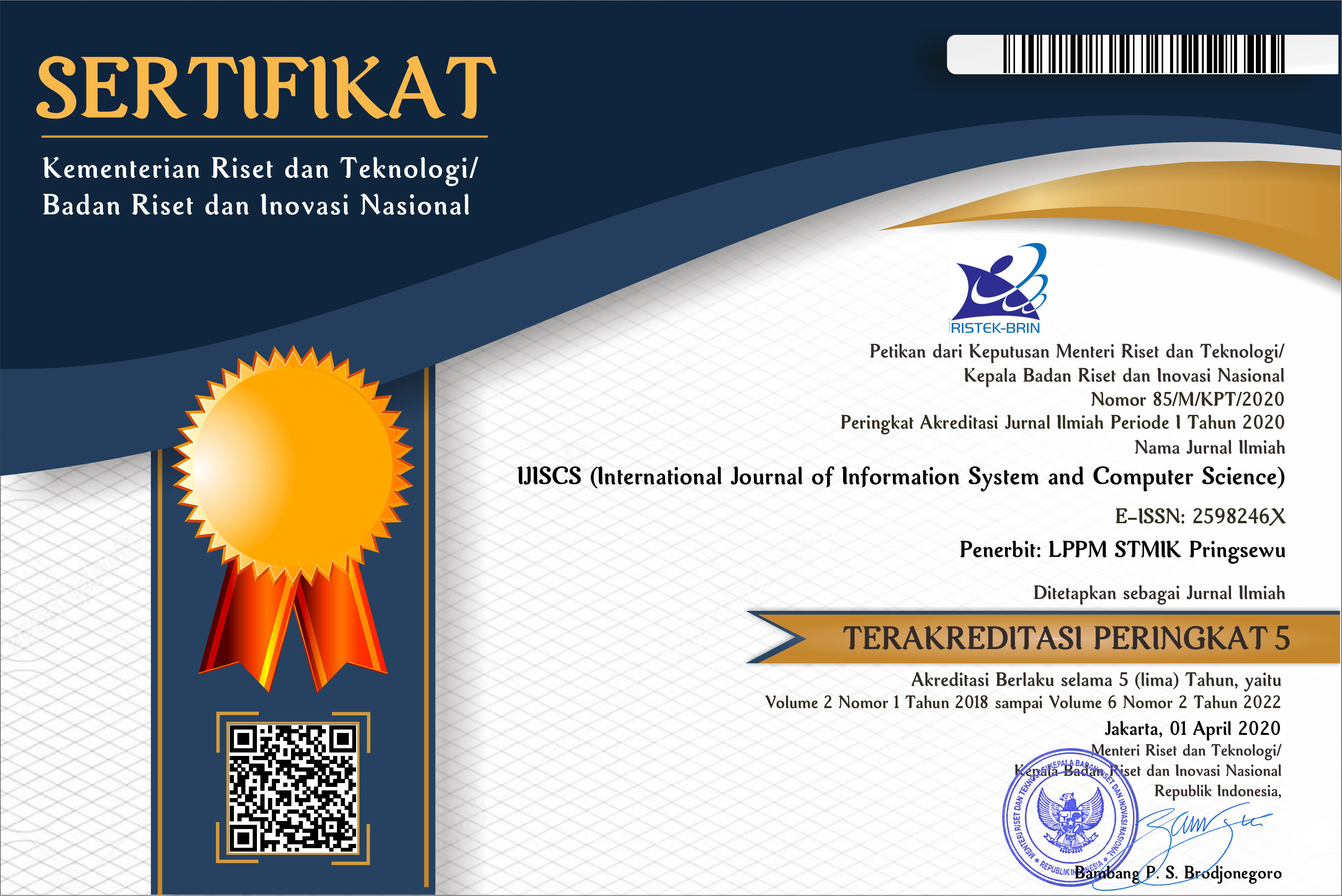DATA LOSS PREVENTION USING POST QUANTUM CRYPTOGRAPHY: OVERVIEW OF ROUND-3 ALGORITHMS
(1) Department of Computer Science, Akanu Ibiam Federal Polytechnic Unwana. Ebonyi State
(2) Department of Computer Science, Cross River State University of Technology, Cross-River State
(3) Department of Computer Science, Cross River State University of Technology, Cross-River State
(4) Department of Computer Science, Akanu Ibiam Federal Polytechnic Unwana. Ebonyi State
 Corresponding Author
Corresponding Author
Abstract
The current hype of quantum computing has necessitated the need for computer security stakeholders to call for the design of security algorithms that will be quantum efficient when quantum computers finally grace our computing sphere. Recent advancements in quantum computing have made cryptographic schemes more vulnerable to quantum attacks like Shor’s algorithm and Grove’s algorithm. Therefore NIST call for a new set of algorithms known as Post-Quantum cryptography that would be quantum proof is imminent. Many Post quantum algorithms have been designed and tested. But only few of them made it to the round 3 (the final round). This paper reviewed these post quantum candidates. Literatures highlighting their scheme, properties, implementation and areas of security coverage was reviewed. Recommendations on future research areas in this field was itemized for this novel security paradigm as we await the final standardization of this cryptosystems.
Keywords
References
Research Institute. 2021. A Guide to Post-Quantum Cryptography. https://medium.com/hackernoon/a-guide-to-post-quantum-cryptographyd785a70e-a04b.
Onuora, A. C., Madubuike, C. E., Otiko, A. O. and Nworie, J. N. 2020. Post-Quantum Cryptographic Algorithm: A systematic review of round-2 candidates. Academia in Information Technology Profession AITP.
Zentachain. 2021. Quantum Computers & Encryption. https://medium.com/@zentachain/ quantum-comp uters-encryption-b3d407da5099 (retrieved May 2, 2021).
Horowitz, M. A., Aspuru-Gujzik,A., Awschalom, D. D. , B Blakley, B., Boneh, D., Coppersmith, S. N. and Vazirani, U. V. 2019. Quantum computing’s implications for cryptography. In Quantum computing.
Renty, D. 2021. Status of post-quantum cryptography. https://www.riskinsight-wavestone.com/en/ author/david-renty/ (retrieved May 2, 2021).
Post-Quantum Cryptography. 2021. NIST Computer Security Resource Center | CSRC. https://csrc.nist.gov/Projects/post-quantum-cryptography/post-quantum-cryptograp hy-standardization. (Retrieved May 1, 2021).
Sumagita, M., and Riadi, I. 2018. Analysis of Secure Hash Algorithm (SHA) 512 for Encryption Process on Web Based Application. The International Journal of Cyber-Security and Digital Forensics (IJCSDF) 7, no. 4.
Kapis, K., and Mshangi, M. 2018. Privacy protection of Users’ Data in Social Network Systems based on Homomorphic Cryptography Techniques. The International Journal of Cyber-Security and Digital Forensics (IJCSDF) 7, no. 4.
Dehkordi, M. H., Asgari, A. and Moradian, A. 2018. A New Scheme to Secure Communication and Data, based on the Integration of Cryptography and Steganography. The International Journal of Cyber-Security and Digital Forensics (IJCSDF) 7, no. 2.
Swinhoe, D. 2021. The 15 Biggest Data Breaches of the 21st Century. CSO Online. Last modified January 8, 2021. https://www.csoonline.com/ article/2130877/the-biggest-data-breaches-of-the-21st-century.html
Buchmann, J. A., Butin, D., Göpfert, F. and Petzoldt, A. 2016. Post-quantum cryptography: State of the art. The New Codebreakers, 88-108. doi:10.1007/978-3-662-49301-4_6.
Koziel, B., Azarderakhsh, R., Mozaffari Kermani M., and Jao, D. 2017. Post-quantum cryptography on FPGA based on Isogenies on elliptic curves." IEEE Transactions on Circuits and Systems I: Regular Papers 64, no. 1, 86-99. doi:10.1109/tcsi.2016.2611561.
Costello, C. 2017. An introduction to supersingular isogeny-based cryptography.
Endignoux, G. 2017. Design and implementation of a post-quantum hash-based cryptographic signature scheme (Unpublished master's thesis)." Ecole Polytechnique of Palaiseau.
Yang, B. 2021. Multivariate Quadratic Public-Key Cryptography In the NIST Competition. https://www.maths.ox.ac.uk/system/files/attachments/MQ%20Public-Key%20Crypto %20 in%20the%20NIST%20competition.pdf (retrieved May 5, 2021).
Rijneveld, J. 2016. Practical Post-Quantum Cryptography - Joost Rijneveld. Joost Rijneveld, joostrijneveld.nl/thesis/.
Nejatollahi, H., Dutt, N., Ray, S., Regazzoni, F., Banerjee, I and Cammarota, R. 2019. Post-Quantum Lattice-Based Cryptography Implementations. ACM Computing Surveys 51, 1-41.
Faux, R. 2019. Mitigating the Quantum Threat with Hybrid Cryptography." Cloud Security Alliance. https://cloudsecurityalliance.org
Alagic, G., J. Alperin-Sheriff, D. Apon, D. Cooper, Q. Dang, Y. Liu, C. Miller, et al. 2019. Status report on the first round of the NIST post-quantum cryptography standardization process. NISTIR 8240. doi:10.6028/nist.ir.8240.
Borges, F., Reis, P. R. and Pereira, D. 2020. A Comparison of Security and its Performance for Key Agreements in Post-Quantum Cryptography. IEEE. doi:10.1109/ access.2020.3013250.
Sikeridis, D., Kampanakis, P. and Devetsikiotis, M. 2020. Assessing the overhead of post-quantum cryptography in TLS 1.3 and SSH. Proceedings of the 16th International Conference on emerging Networking Experiments and Technologies. doi:10.1145/3386367.3431305.
Schwabe, P., Stebila, D. and Wiggers, T. 2020. Post-Quantum TLS Without Handshake Signatures. Proceedings of the 2020 ACM SIGSAC Conference on Computer and Communications Security. doi:10.1145/3372297.3423350.
Saarinen, M. 2020. Mobile Energy Requirements of the Upcoming NIST Post-Quantum Cryptography Standards. 2020 8th IEEE International Conference on Mobile Cloud Computing, Services, and Engineering (MobileCloud). doi:10.1109/mobilecloud48802.2020.00012.
Bobrysheva, J., and Zapechnikov, S. 2020. The Relevance of Using Post-quantum Cryptography on the Isogenies of Elliptic Curves for Mobile Application Protection. Advanced Technologies in Robotics and Intelligent Systems, 99-103. doi:10.1007/978-3-030-33491-8_11.
Djordjevic, I. B. 2020. Joint QKD-Post-Quantum Cryptosystems. IEEE Access 8, 154708-154712. doi:10.1109/access.2020.3018909.
López-García, M., and Cantó-Navarro, E. 2020. Hardware-Software Implementation of a McEliece Cryptosystem for Post-quantum Cryptography. Advances in Intelligent Systems and Computing, 814-825. doi: 10.1007/978-3-030-39442-4_60.
Fernandez-Carames, T. M., and Fraga-Lamas, P. 2020. Towards Post-Quantum Blockchain: A Review on Blockchain Cryptography Resistant to Quantum Computing Attacks. IEEE Access 8, 21091-21116. doi:10.1109/access.2020. 2968985.
Cohen, A., D'Oliveira, R. G., Salamatian, S. and Medard, M. 2021. Network Coding-Based Post-Quantum Cryptography. IEEE Journal on Selected Areas in Information Theory 2, no. 1, 49-64 (2021). doi:10.1109/jsait.2021.3054598.
Ott, D. and Peikert, C. 2021. Identifying Research Challenges in Post Quantum Cryptography Migration and Cryptographic Agility. "https://cra.org/ccc/wp-conntent/uploads/sites/2/ 2018/11/CCC-Identifying-Research-Challenges-in-PQC-Workshop-Report.pdf (retrieved May 5, 2021).
Article Metrics
Abstract View : 301 times
: 301 times Download : 49 times
Download : 49 times
DOI: 10.56327/ijiscs.v5i3.1061
Refbacks
- There are currently no refbacks.






